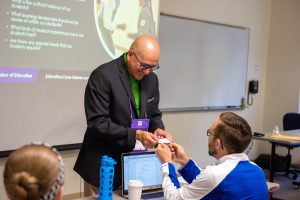CORNERSTONE 3: ENGAGING IN EFFECTIVE INSTRUCTION
In the first two articles, I shared strategies related to planning, preparation and how to create a positive learning environment. The focus of this article is all about Cornerstone 3, how to engage in effective instruction. Let’s look at six strategies related to effective instruction.
First of all, it’s important to communicate the expectations for learning at the beginning of class using directions, procedures, and explanations. Frequently, school districts prefer a unified template that is consistent for all classes because it provides a cohesive setting for students throughout the entire day. Years ago, for example, my district was a proponent of having the teachers post the topic, level, and assessment, or the TLA, for each class. Basically, by incorporating the TLA model, teachers were communicating what was going to be taught, at what depth of understanding and how we were going to assess if the students were successful in learning the topic of the day.
I must admit, at first, I had mixed feelings about being “required” to implement the TLA process. However, over time, I realized that I was becoming more intentional with my teaching by utilizing this three-step system. I also realized that some of the students appreciated the structure and consistency of the TLA process because they knew what the plan for the day was and also knew if we accomplished what we set out to do. They walked out of class knowing precisely what they had achieved, and more often than not, they knew what to expect for the next rehearsal.
The next strategy is to include prepared and thoughtful questions throughout rehearsals to engage students in higher-level thinking. Now, I know that most music students and teachers just want to make music for as much of the rehearsal as possible, and there is much to be said for playing more and talking less. However, there is value in taking intentional time to present thoughtful questions that engage students in reflection and critical thinking. It can serve as an effective means of assessment and, frequently, help students retain knowledge more successfully. Keep in mind that when we present questions to our students to allow about four to six seconds of “thinking time”. This allows them to process the question and then engage in better-developed responses.
The third strategy for engaging in effective instruction is to keep all our students engaged by multi-tasking. For example, sectionals, can be a very effective way to engage students if they have been taught the appropriate expectations that allow for success. I suggest that we create a sectional handout that helps our students organize and structure the sectional process, much like how we develop our own lesson plans. The key here is to take the time up front to properly teach our students how to run sectionals and not just assume that they have the skills to figure it out by themselves.
The fourth strategy involves using creative instructional pairings, groupings, or seating arrangements to increase efficiency and learning. Rather than consistently using a standard seating arrangement, be creative and intentional by using a variety of seating arrangements to positively impact learning. For example, consider pairing our more experienced musicians with the younger musicians. There are tons of benefits in pairing students together. Another idea is to group students with similar parts, even though they may play different instruments. By altering the seating arrangement, this provides an opportunity for students to improve their listening skills. How about organizing chairs in concentric circles around us? It’s another effective, and fun, way to increase communication among the students, especially if the rehearsal is not always conducted.
The next strategy is to be cautious with repetition. Let’s face it, most music teachers are guilty of the phrase, “Okay kids, let’s do it one more time!” Now, it’s true that repetition is fundamental to mastering the many skills involved with music-making. And, repetition is a very important life skill that leads to perseverance in the real world. The key is to use repetition to reinforce proper performance and behaviors. Just be careful to avoid repetition if inappropriate habits are being unintentionally reinforced.
The sixth and final strategy for engaging in effective instruction is to demonstrate flexibility and responsiveness while also being persistent about quality. Successful educators create for themselves a structured environment and lesson plan. But, they also realize when a “teachable moment” presents itself during class and seize upon those opportunities. Furthermore, there are times when there is a need to monitor and adjust for any number of reasons. At the end of the day, students will appreciate our willingness to be flexible and responsive while still expecting persistence and achievement.
In the first three articles, I’ve shared cornerstone strategies on preparation for effective teaching, strategies for creating a positive learning environment, and how to engage in effective instruction. In the next article, the fourth cornerstone will focus on developing five effective assessment strategies.
Until then, here’s to your success!

